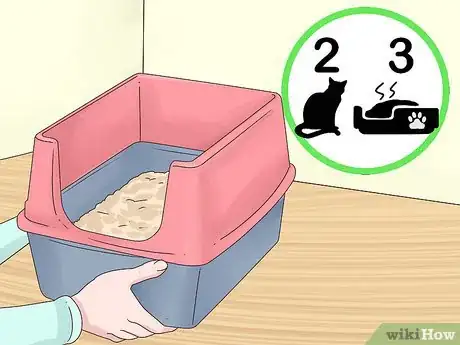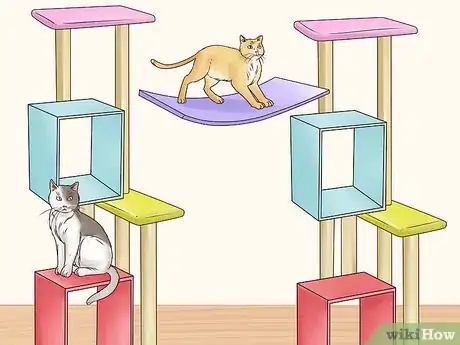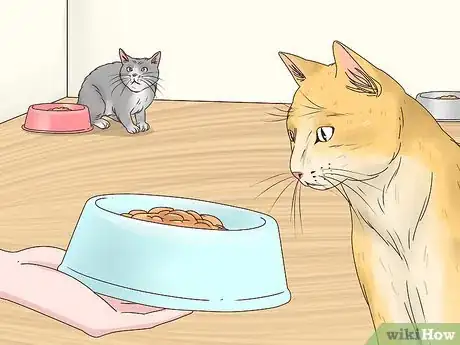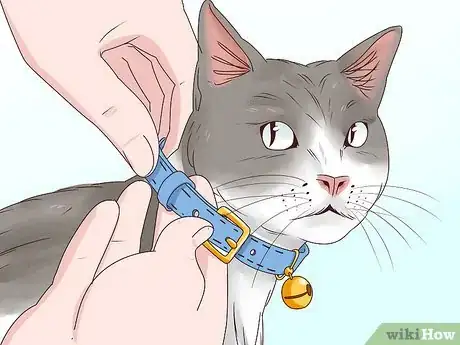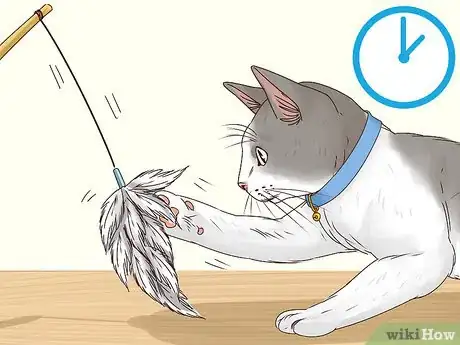This article was co-authored by Ryan Corrigan, LVT, VTS-EVN. Ryan Corrigan is a Licensed Veterinary Technician in California. She received her Bachelor of Science in Veterinary Technology from Purdue University in 2010. She is also a Member of the Academy of Equine Veterinary Nursing Technicians since 2011.
There are 9 references cited in this article, which can be found at the bottom of the page.
This article has been viewed 46,878 times.
Litter box aggression is when one cat attacks another cat while it is using the litter box. This is usually as a power play or intended to intimidate the other cat into not using the litter box. It can often be fixed by making some small adjustments in your home – like adding another litter box or creating more spaces for your cats to be active in. If the aggressive behavior gets too extreme, you may need to contact your veterinarian for help fixing the problem.
Steps
Making Changes in Your Home
-
1Add another litter box. The main cause for litter box aggression in cats is too few litter boxes in the home. Simply adding another litter box can often dispel much of the tension that is causing your cat to act aggressively.[1]
- The general rule of thumb is that you should have one litter box per cat, plus one. For example, if you have two cats, you should try to have three litter boxes in your home.
- You should also make sure that the litter boxes are cleaned regularly. Try cleaning the litter boxes more frequently than you normally do to see if this helps the behavior.
- If you don't clean the litter boxes frequently, your cats will naturally gravitate toward the cleaner box. A dominant cat will try to protect the cleanest boxy, making it difficult for the other cats to access it. This can lead to accidents.
-
2Create more perching space for your cats. Cats need room to roam and be active in your home. Sometimes litter box aggression can be caused by cats not having enough space to move in your house. Adding some extra climbing or perching structures can give your cats more mobility and more space to be active and happy.[2]
- Try adding perches to window sills so your cats can look out the window. Or you might put a kitty climbing tower in the corner.
Advertisement -
3Make additional feeding locations. Even if your cats don’t show aggression during mealtimes, this can still be a source of anxiety. Try adding another food dish so your cat doesn’t feel as possessive of the existing food sources.[3]
- Consider letting your cats self-feed out of a larger food dispenser to alleviate some of the tension. Only do this if your cats are not overweight.
- Try placing the bowls in opposite ends of your house. This will limit traffic among your cats.
-
4Put a bell on the aggressor. Try putting a bell on the aggressive cat’s collar so that the other cats can always tell where it is in the house. While this will not help address the aggressive cat’s behavior, it will help the other cats protect themselves while you are trying to address the behavior problem.[4]
Addressing the Cat’s Behavior
-
1Spend more time playing with the aggressive cat. Sometimes cats who exhibit litter box aggression just need more outlets to expel their energy. Try spending a bit more focused play time with the aggressive cat each day and see if that helps the unwanted behavior.[5]
- Try throwing a toy mouse around for your cat to chase. Or use a string toy to get your cat to run around following it. Use a feather toy to entice your cat to jump up and grab it. Any active game is good for expending excess energy.
- If it is safe, try to facilitate positive playtime for all the cats in your house. If they can't play safely, go back to individual playtime.
-
2Give the cat choices. Your cat may be aggressive about the litter box because it prefers one location over another, or it likes a certain kind of litter better. In any case, it’s important to give your cats choices. Try using several different kinds of litter (one in each litter box) so that your cat may choose which one it likes best.[6]
- Try using one fine grain litter, one clumping litter, one larger grain litter. See which one your cats prefer.
- Not which litter your cats like better. If they all prefer one kind, change all the litter to their preferred choice so that there is no competition for the favored box.
-
3Separate the cats. If the aggressive behavior gets too extreme, try separating the cats for a few days. Make sure each cat has everything they need in their own space – food, fresh water, a clean litter box, and several toys.[7]
- Make sure you still take some time each day to hang out and play with each cat. Don’t just isolate them.
-
4Use positive reinforcement. To help your cat overcome its aggressive behavior, use positive reinforcement. This means that you should provide your cat with treats and praise when you notice that it doesn’t bother the other cats while they are using the litter box.[8]
- Don’t give your cat a treat every single time, as this could contribute to a weight problem.
- Never use negative reinforcement. Don’t yell at or hit your cat when you see it acting aggressively. This will only perpetuate the problem.
- Instead, try to distract the aggressive cat with something more interesting (attention from you, play time, etc.) and then reward the behavior with praise or (occasionally) a treat.
Getting Professional Help
-
1Ask a professional cat trainer. It might be helpful to hire a professional cat trainer to come to your home and help you with the problematic behavior. A professional will be able to make sure that your home is set up in a way that is conducive to happiness and satisfaction for the cats.
- A trained professional can also make observations about your cat’s specific behaviors and give you advice that is tailored specifically for your cat’s issues.
-
2Consult your veterinarian. If the behavior is getting out of hand, you may want to consider asking your veterinarian for their advice. A vet has trained experience working with problems like this and will be able to offer you additional recommendations.[9]
- Your vet will also be able to check to see if there is any underlying medical condition causing the aggressive behavior.
- Aggressive behavior can sometimes be linked to medical conditions that cause pain for your cat – like arthritis or dental diseases – or to central nervous system conditions such as hyperthyroidism.[10]
-
3Consider psychoactive medication. If you have tried adjusting your home and addressing the cat’s behavior, it might be time to consider some psychoactive medication like lorazepam. This kind of medication can help decrease the cat’s aggressive tendencies and alleviate a lot of the stress that your cats are feeling.[11]
- This option should only be considered in extreme circumstances once you have attempted to alter the behavior in other ways.
- These kinds of medication can have a sedating effect on the cat, which is normal. But you may need to change the dosage if your cat seems too sedated.
References
- ↑ https://www.dvm360.com/view/just-ask-expert-taming-litter-box-aggression
- ↑ http://www.catbehaviorassociates.com/cat-fights-what-to-do-when-your-cats-turn-on-each-other/
- ↑ http://tenthlifecats.org/all-about-cats/cat-behavior/intra-cat-aggression
- ↑ http://www.petmd.com/cat/conditions/behavioral/c_ct_aggression_intercat?page=2
- ↑ https://www.aspca.org/pet-care/cat-care/common-cat-behavior-issues/aggression-between-cats-your-household
- ↑ https://www.petfinder.com/cats/cat-problems/litter-box-etiquette/
- ↑ http://www.vet.cornell.edu/fhc/Health_Information/brochure_aggression.cfm
- ↑ http://www.humanesociety.org/animals/cats/tips/training_your_cat_positive_reinforcement.html
- ↑ http://www.humanesociety.org/animals/cats/tips/aggression_between_cats.html
About This Article
The best way to prevent litter box aggression is to set up another litter box in your home, since the main cause of the aggression is usually too few litter boxes. In general, it's best to set up one litter box per cat, plus an extra one, to keep tension in check. It's also important to keep all of the litter boxes equally clean so that dominant cats won't block access to the cleanest box. If the aggressive behavior gets too extreme, try separating the cats for a few days. Make sure each cat has everything they need in their own space, like food, fresh water, a clean litter box, and several toys. For more tips from our Veterinary co-author, like how to handle continued aggression in dominant cats, read on!
